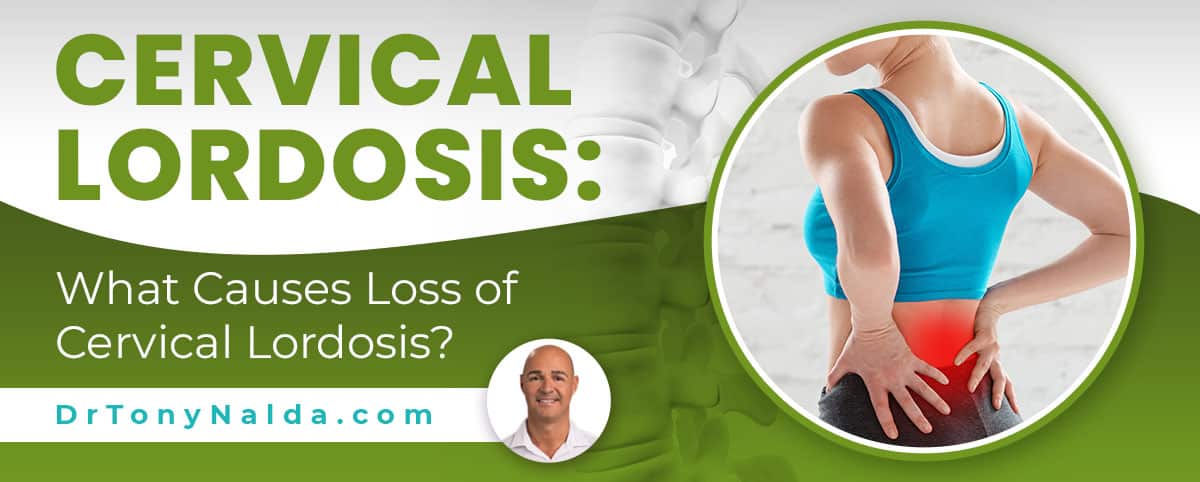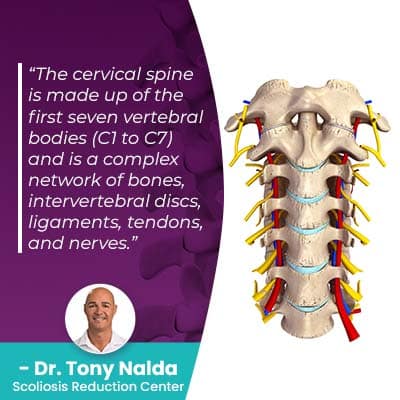Cervical Lordosis: What Causes Loss of Cervical Lordosis?

At each of the spine’s main sections, there is a natural range of curvature degrees; if a section of the spine develops a curve that falls beyond a normal range, problems can occur. The cervical spine is important for several reasons, one of which is supporting the weight of the head, and if the neck loses its natural lordosis and becomes excessively straight, a number of issues can develop.
The spine has three main sections, and the cervical spine refers to the neck. If there is a loss of cervical lordosis, this means the neck’s natural inward C-shaped curvature is lost, causing the cervical spine to become unnaturally straight and introducing adverse spinal tension.
Before getting to the specifics of what it means to experience a loss of cervical lordosis, let’s first explore some basic spinal anatomy for a clearer understanding of how the spine functions.
Table of Contents
Basic Anatomy of the Spine
The spine’s natural curves make it stronger, more flexible, and better able to absorb and distribute stress throughout the day.
There are three main spinal sections: cervical (neck), thoracic (middle/upper back), and lumbar (lower back).
Each spinal section has a characteristic curvature type, either bending inward towards the body’s center in a C-shape (lordosis), or bending outwards, away from the body’s center, in a reverse C-shape (kyphosis).
The spine’s natural lordosis is found in the cervical and lumbar sections, while the spine’s natural kyphosis involves the thoracic spine.
As mentioned, the spinal sections have a natural curvature-degree range, and as long as a person stays within those normal ranges, the spine’s biomechanics are preserved, but if a curvature degree falls beyond a normal range, the entire spine’s biomechanics are disrupted.
The normal curvature-degree ranges are as follows:
- Cervical lordosis: 20 to 40 degrees
- Lumbar lordosis: 40 to 60 degrees
- Thoracic kyphosis: 20 to 40 degrees
In order for the spine to function optimally, its natural curvatures and alignment have to be preserved, and each curvature is dependent on the health of the others; when one spinal section loses a healthy curve, the spine can respond by putting in a compensatory curve in an attempt to counteract the adverse spinal tension introduced by the first unnatural curve.
Each spinal section is important and plays a role in its overall health and function, including the cervical spine, so let’s move on to the specifics of why a healthy neck is important.
The Cervical Spine
A healthy spine consists of vertebrae (bones of the spine) stacked on top of one another in a straight and neutral alignment, and the cervical spine refers to the uppermost portion of the spinal column.
 The cervical spine is made up of the first seven vertebral bodies (C1 to C7) and is a complex network of bones, intervertebral discs, ligaments, tendons, and nerves.
The cervical spine is made up of the first seven vertebral bodies (C1 to C7) and is a complex network of bones, intervertebral discs, ligaments, tendons, and nerves.
Both durable and fragile, the neck has the important task of supporting the head, which on average weighs approximately 10 to 11 pounds.
Not only does the cervical spine have to support the weight of the head, but it also protects the spinal cord, facilitates a wide range of motion (nodding, turning the neck from side to side, looking up and down), and is the connection between the brain and the rest of the body.
So what happens if the neck becomes unnaturally straight?
Straightening of the Cervical Lordosis
As mentioned, the neck’s natural lordosis makes the cervical spine bends inward in a C-shape, and if that curvature degree falls within the range of 20 to 40 degrees, this is considered a normal and healthy range of cervical kyphosis or lordosis. If a person experiences a loss of cervical lordosis and doesn’t fall within that normal range, this means the neck becomes excessively straight.
When the neck is too straight, what’s known as forward head posture is often introduced, and a related condition known as military neck can also become an issue.
Forward head posture refers to when a person’s head shifts forward unnaturally, and this increases the weight of the head on the neck; in fact, it’s said that a forward shift in the head’s posture as little as one inch can increase the weight of the head by 10 pounds.
Military neck refers to the appearance that an excessively-straight neck can give a person: the traditional military posture of standing at attention.
Loss of cervical lordosis, also known as hypolordosis, can be caused by various factors such as poor posture, degenerative changes in the spine, trauma, or muscle imbalances.
When there is a straightening of cervical lordosis, this disrupts the entire spine’s biomechanics, making it vulnerable to injury, impairing its ability to properly support the weight of the head, places extra pressure on the cervical discs (increasing the rate of disc degeneration), and introduces adverse muscle and joint tension.
So, in addition to how it can affect the body’s appearance in terms of posture, the following are some common symptoms of a loss of cervical lordosis:
- Increased risk of injury
- Muscle tension in the neck and shoulders
- Pain in the neck and shoulders
- Cervical disc degeneration (increased risk of developing a bulging or herniated disc)
In addition, there is also what’s called a reversal of cervical lordosis or a reverse curve, and this involves the vertebrae in the neck’s curve bending in the wrong direction, becoming more kyphotic than lordotic.
Now that we have defined a loss of cervical lordosis, a reversal of cervical lordosis, and discussed the issues a straightening of cervical lordosis can cause, let’s address causation.
What Causes Loss of Cervical Lordosis?
As is the case with most spinal conditions, there can be multiple causes for a loss of cervical lordosis, but among the most common are what’s become known as tech neck, uneven weight distribution, chronic poor posture, leading a sedentary lifestyle, and the presence of an underlying spinal condition like scoliosis.
 Tech neck refers to the modern tendency of constantly looking down at screens; over time, this can stress the muscles that support the neck and head, causing them to become stiff, strained, and sore.
Tech neck refers to the modern tendency of constantly looking down at screens; over time, this can stress the muscles that support the neck and head, causing them to become stiff, strained, and sore.
The more a person looks down, the harder the muscles have to work to maintain the head’s upright position.
Over time, the tech neck can cause a loss of cervical lordosis as the cervical spine is exposed to adverse spinal tension, and the muscles that help support the weight of the head by supporting and stabilizing the cervical spine become weak due to strain.
Uneven weight distribution, such as carrying a heavy backpack slung over one shoulder repeatedly, can also, over time, weaken the cervical muscles and spine due to the introduction of uneven forces and pressure.
Chronic poor posture goes along with tech neck and involves not holding the body properly, including not lifting heavy objects properly (with the legs vs. the back) without straining the spine and risking injury.
Chronic poor posture means exposing the spine to uneven forces that can cause the spine to become misaligned, strained, degenerate faster, and increase the risk of injury.
Loss of cervical lordosis can be caused by poor posture, trauma, or degenerative spinal conditions, and it's important to be aware of scoliosis exercises to avoid that might exacerbate this condition.
The loss of cervical lordosis, which refers to the curvature of the neck, can occur due to various factors and may lead to complications, though mild straightening of the cervical spine is not necessarily dangerous; however, understanding the causes, such as poor posture, injury, or degenerative conditions, is crucial in addressing and potentially restoring normal cervical lordosis through interventions like physical therapy, ensuring a healthy cervical spine alignment and function, similar to maintaining proper curvature in the lumbar spine.
The very design of the spine is based on movement, so leading a sedentary lifestyle is contrary to the spine’s natural function and biomechanics.
The spine’s many components work together to facilitate movement and flexibility, so if a person isn’t maintaining a healthy activity level, the spine and its surrounding muscles can become stiff, which impairs blood flow, can cause muscle soreness, and further increases the risk of injury.
The presence of an underlying spinal condition like scoliosis can be a potential cause of a loss of cervical lordosis because the condition involves an unnatural sideways spinal curve, with rotation, that can affect the cervical spine.
When it comes to a reversal of cervical lordosis, causes can include postural issues, accidents, injuries (overuse injuries), and underlying spinal conditions such as scoliosis and osteoporosis.
The loss of cervical lordosis can be caused by several factors, including sagittal imbalance and retrolisthesis, which can alter the natural curvature of the neck and lead to discomfort and other spinal issues.
Scoliosis introduces uneven forces to the body, and one of its main symptoms is postural deviation. For someone with cervical scoliosis, this can cause the neck to lose its natural and healthy lordosis.
Conclusion
A healthy spine will appear straight if viewed from the front or back and will take on a soft ‘S’ shape when viewed from the sides; this is due to the spine’s natural and healthy curves.
The three main spinal sections each have a characteristic curvature type known as kyphosis and lordosis.
Kyphosis refers to the spine’s natural outward bend, in reverse ‘C’ shape, which affects the thoracic spine, while lordosis refers to the spine’s natural inward bends, in a standard ‘C’ shape, at the cervical and lumbar sections.
A loss of cervical lordosis means the neck has become excessively straight, which can cause a number of issues such as forward head posture and military neck.
Loss of cervical lordosis can result from poor posture, injury, or muscle imbalances, causing decreased lordosis or even a reversed cervical lordosis. Incorporating cervical hyperlordosis exercises and specific cervical lordosis exercises can help strengthen neck muscles, alleviate discomfort, and restore proper cervical and lumbar lordosis alignment, potentially reducing headache disorders associated with these conditions.
Here at the Scoliosis Reduction Center, I have experience treating various spinal conditions, including a loss of cervical lordosis.
When it comes to effective treatment, the underlying cause has to drive the design and customization of lordosis treatment plans.
Once the cause of cervical lordosis loss has been determined, it’s addressed by the treatment that integrates lifestyle guidance, chiropractic adjustments, in-office therapy, and rehabilitation.
While there are no treatment guarantees, by proactively addressing the underlying cause of the curvature loss, I can help patients regain as much natural cervical lordosis as possible, improving the spine’s overall health and function.
Dr. Tony Nalda
DOCTOR OF CHIROPRACTIC
After receiving an undergraduate degree in psychology and his Doctorate of Chiropractic from Life University, Dr. Nalda settled in Celebration, Florida and proceeded to build one of Central Florida’s most successful chiropractic clinics.
His experience with patients suffering from scoliosis, and the confusion and frustration they faced, led him to seek a specialty in scoliosis care. In 2006 he completed his Intensive Care Certification from CLEAR Institute, a leading scoliosis educational and certification center.
About Dr. Tony Nalda
 Ready to explore scoliosis treatment? Contact Us Now
Ready to explore scoliosis treatment? Contact Us Now





